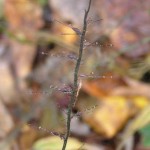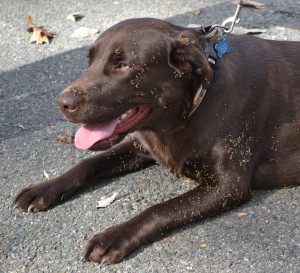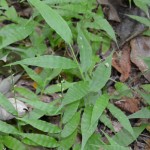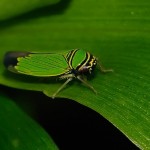by Kristen Minogue
Fourteen years ago, a green, hairy and incredibly sticky plant appeared in a Maryland park. Now it has biologists all over the state worried. But does this South Asian forest grass have what it takes to be a serious invader?
It goes by the name wavy-leaf basketgrass. However, to call it an invasive species would be a mistake. Technically it’s an invasive “subspecies,” a vague, somewhat arbitrary term that means it can breed with other basketgrasses, but it’s become different enough – usually by adapting to a certain location – to get its own category. (To make that less confusing, here are a couple of things it’s not: It’s not the standard basketgrass Oplismenus hirtellus native to Puerto Rico, and it’s not the subspecies bristle basketgrass native to the southern and midwestern United States.)
Researchers first discovered it in Patapsco Valley State Park in 1996. Smithsonian botanist Paul Peterson identified it as wavy-leaf basketgrass shortly afterward. For a while managers thought they could contain it in Maryland. But four other populations have sprouted up in Virginia – turning it from a state problem to a mid-Atlantic problem.

When in seed, wavy-leaf secretes droplets of glue that lets its seeds latch onto unsuspecting hikers. (Kerrie L. Kyde)
1) It can spread. Rapidly. Its seeds are encased in a translucent goo that will stick to practically anything – deer, dogs or people. Though some wild animals may be smart enough to avoid the plant when it’s in seed (probably because it’s such a nuisance to get off), all it takes is one dog on a leash to tramp through the understory and the seeds will be able to hitchhike wherever the animal goes next.
2) It’s adaptable. It thrives in the deep shade, but it can grow under a wide range of light levels. It does better when the layers of leaf litter go deeper – but they’ve seen it doing well where leaf litter is shallow as well. The amount of moisture in the soil doesn’t seem to affect it at all. The only thing Beachamp’s team found that throws the plant off is proximity to beech trees. No one’s sure why.

Wavy-leaf seeds. Beauchamp's team ran dogs through sections of wavy-leaf in the forest to see how much of the plant would latch onto their fur. Anwer: Too much. (Vanessa Beauchamp/Towson University)
3) It can (possibly) drive out other species. Areas with a wide variety of species tended to have less wavy-leaf basketgrass, at least in the places Beauchamp studied. Meanwhile wavy-leaf grew best in spots where it occurred alone. This could mean one of two things: One, wavy-leaf can’t compete with other species and can only colonize empty space. Or two: It’s already driven out species in the places where it now reigns, and it’s in the process of driving them out everywhere else. In other words, it’s either a very bad competitor or a very, very good one. 4) It has no natural enemies. Technically it has one. The leafhopper insect Tylozygus geometricus likes to poke holes in its leaves just before they dry out. But at that point, the leaves have served their purpose and will die anyway, meaning whatever damage the leafhopper does won’t bother the plant that much. So really it has no natural enemies.
Fortunately if the plant is launching a determined invasion into the U.S., it’s still in the early stages. Biologists are working to slow its spread as much as possible. Roundup and old-fashioned weed pulling do a decent job killing it. Meanwhile, here are a few tips for nature-lovers who stumble across it: If you see it, avoid it. If some of the seeds do get stuck to your clothes, your pet, or anything else you carry around, get them off before leaving the area. Lastly, concerned residents can report sightings to the Maryland DNR.




I live in Creola, Alabama and have found this in my backyard. It seems to be taking over. Any information you can give me on how to get rid of it would be greatly appreciated.
Thank you.